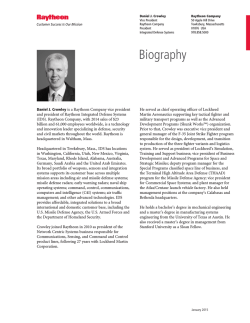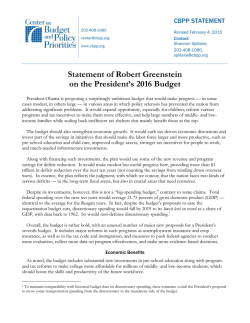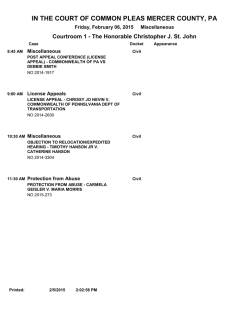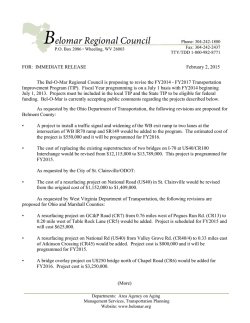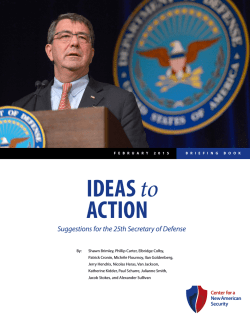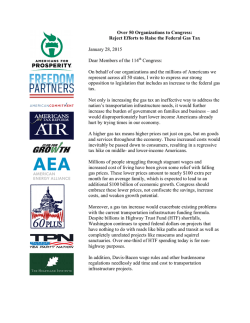
Download PDF file of "Balancing Strategy, Resources and Politics"
Balancing Strategy, Resources and Politics: Options for the President’s FY2016 Budget Request By Ryan Crotty and Clark Murdock January 28, 2015 On February 2, 2015, President Obama will submit to Congress his budget request for FY2016 and lay out his plans for the next five years (FY2016-2020). This will be the last budget both built and executed by the Obama administration. With the stability provided by the Ryan-Murray Bipartisan Budget Act in the past, the debate over how much to spend on defense and how to pay for it will return with a vengeance. In the absence of another budgetary agreement like Ryan-Murray, the full sequestration caps mandated by the Budget Control Act (BCA) of 2011 will be enforced in FY2016. The global security environment worsened during 2014 on many fronts — Ukraine (fueled by Russian revanchism), Iraq and Syria (with the establishment of the Islamic State) and global terrorism (with attacks from homegrown jihadists), to name only the most threatening. Given the proliferation of global threats, it is debatable whether the FY2014-2015 defense budgets, even with the RyanMurray budget relief, adequately funded the administration's national security strategy (a subject we'll return to). There is little debate, in fact there appears to be a broad consensus from lawmakers in both chambers and from the executive branch, that defense spending at the statutory BCA cap is too low. Nonetheless, the political realities around the tradeoffs required to increase spending will be difficult to overcome. Where things stand now FY 2016 presents clear opportunities for both the best and worst cases for the near term prospects for the defense budget. Figure 1 displays the tradespace for aligning defense strategy to the Department of Defense (DoD) base budget. The upper bound of that tradespace is the President’s FY 2013 budget request (PB13, dotted blue line). Presented in January 2012, before sequester became a reality, the PB13 was developed in concert with the 2012 Defense Strategic Guidance (DSG). At the time, military and civilian leaders in the Department of Defense insisted that U.S. strategy was fully funded. To many, this budget level represents the full funding of the United States’ current strategy. However, as displayed in the solid black line, the defense budget fell far short of PB13, but the debate over defense spending was muted. Why? First, the cuts to the defense budget could have been worse, since Ryan-Murray provided some relief (about $28 billion dollars) to the BCA caps, which are displayed in red and represent the "floor" of the tradespace for DoD's budget cap. However, the gap between PB13 and the BCA caps is about $50 billion a year, so the base budget still came down an average of $36 billion per year in FY2014-15. 1 Figure 1: Framing the Debate over DoD's Base Budget $580 $560 Constant 2015 $ billions $540 $520 $500 $480 $460 2012 2013 Actuals 2014 2015 PB13 2016 2017 2018 Ryan-Murray Extended 2019 2020 2021 2022 BCA Sequester-level Caps Source: Department of Defense, National Defense Budget Estimates for FY 2015 (Green Book), Office of the Under Secretary of Defense (Comptroller), April 2014; Pat Towell and Amy Belasco, Defense: FY2014 Authorization and Appropriations, Congressional Research Service, January 8, 2014; CSIS analysis The principal reason why complaints about the growing gap between the 2012 DSG (as expressed in PB13) and the actual base budget were suppressed was the safety valve provided by the Overseas Contingency Operations (OCO) account. OCO funding dropped from $82 billion in FY2013 to $64 billion in FY2015, but troop levels in Afghanistan fell much faster. In his deft deconstruction of the FY2015 defense budget, CSBA budget analyst Todd Harrison notes that the cost (in OCO dollars) per troop in Afghanistan had averaged $1.2 million for FY2005-FY2013, but increased sharply in FY2014 (to $2.3 million per troop) and FY2015 (to $4.6 million per year). While some of this increase could be attributed to a changing ratio of tooth-to-tail in deployed troops, much of it reflects the movement of funding of activities from the base budget to OCO by DoD and Congress (including costs of maritime presence, training, and equipment upgrades). For example, defense appropriators moved $10.2 billion from DoD's FY2014 budget request into OCO in order to make room for Congressional priorities in the base budget. Estimates vary greatly about how much OCO spending is really for base budget programs and activities, ranging from less than $10 billion to $35 billion. For illustration, if the $1.2 million per troop average were to be applied to the expected average FY 2015 force size for Afghanistan (11,661 deployed troops), the total bill for operations would be $14 billion. Adding in the $5 billon cost of the counter-ISIS campaign, these two operations total $19 billion in cost – a full $45 billion below the FY 2015 request. For the purposes of our analysis, we conservatively estimate the costs of these operations to be $20 billion, which 2 means that DoD actually received, via Ryan-Murray and OCO, about $34 billion per year in relief from the BCA caps. With only a $16 billion per year shortfall in a $500+ budget, it is unsurprising complaints were muted. But that assumes that the 2012 DSG is still "good to go" as the defense strategy. As discussed earlier, a lot has happened since January 2012 and many, if not most, believe that the United States must spend more on defense. For comparison purposes, the Ryan-Murphy level of BCA cap relief (about $14 billion per year in constant dollars, shown as the orange line in Figure 1) has been projected over the lifetime of the BCA. Even this modest amount of relief faces an uphill battle for FY2016. The political gaps on the budget fundamentals – taxes, mandatory programs, and discretionary spending – are no smaller than in 2011 when the failure to reach a bipartisan "grand bargain" resulted in the BCA and the imposition of budget caps on both defense and non-defense spending. In this political environment, the extension of the Ryan-Murphy cap relief seems unlikely at best. For more on the political calculus see Ryan Crotty, Post-Election Wrap-Up: What’s Next for Defense Spending. What the President is likely to do – and what he should do The most likely option for the President is to "stay the course" he laid out on his FY2015 budget request – that is, request $35 billion more than the BCA cap allows in FY2016 and project out-year spending at levels declining to about $20 billion above the cap (portrayed as the purple line in Figure 2). In FY2015, this was close enough to the PB13 level that the administration could (and did) claim that the strategy (as expressed by the 2012 DSG) was adequately funded, although with higher degrees of risk. In FY2016, however, this claim will be less believable for two reasons. First, there are unofficial reports (aka RUMINT) that the services’ requests came in as much as $60 billion over the BCA caps, which would be above even the "best case" of the PB13. Second, 2014 was a tumultuous year, and common sense suggests that the threat environment assumed in the 2012 DSG is considerably more benign than the one DoD faces today. Aligning strategy and resources has always been difficult. In our Building the 2021 Affordable Military report, we calculated that the combination of the BCA caps would force a 21 percent reduction in the defense budget (FY2013-FY2021) at the same time that internal cost growth would reduce the buying power of the defense dollar by 15 percent. Projecting how much force structure and modernization would be lost because of this "double whammy" effect was relatively straightforward; estimating what that smaller force was actually capable of was not. We know that the near-term effects of budget cuts mean a less-ready force, but that the longer-term effect is to sacrifice modernization for force structure. We know that the risks and costs (in terms of time and casualties) associated with executing military missions go up as readiness declines, but we don't know where the "knee in the curve" is, particularly when it comes to aligning the aggregate force with the strategy it serves. 3 Answering the question "how much is enough" is difficult, to be sure, but it has to be based on realism and discipline with respect to both strategy and budgets. It is not realistic to claim that a strategy based on a threat environment projected in late 2011 is adequate today. The Budget Control Act of 2011 was passed by the Congress and approved by the President to impose discipline on discretionary spending by the U.S. government, yet the government’s use of OCO funding has been anything but disciplined. The President seems likely to propose a FY2016 defense budget request that amounts to funding an inadequate strategy for today's challenges with an undisciplined budgetary process that conceals base budget spending in the OCO account. The President and DoD can and should do more. The budget exists as both an internal planning instruction and an external guide to DoD’s activities. The budget is the primary oversight guide for Congress and the American people to understand what they are getting for the significant investment in national security. A budget that does not serve this edifying and clarifying purpose, or worse, one that deliberately obfuscates, needs to be changed. One way to re-orient the budget to more clearly describe what is budgeted for in an era of more persistent global engagement and conflict by the military is described below: Acknowledge the threat environment has worsened and adjust the strategy accordingly. Developments in Europe (both Western and Eastern), Iraq-Syria, Africa and Asia have added to the demand for U.S. military capabilities and to argue otherwise fails the Groucho Marx test – "Do you believe me or your own eyes?" Plan for a larger defense base budget. Either re-define OCO to include all overseas operations (not just identified contingencies), or move all funding not in direct support of identified contingencies out of OCO. The OCO account is increasingly a reflection of the changing nature of U.S. global military engagement. This fund now pays for things as wide ranging as European reassurance in the Baltics, counterterrorism in the Philippines, and overhead surveillance and reconnaissance in Africa. It explicitly covers activities in over 20 countries and allows for activities worldwide. DoD started requesting additional funding (first as supplemental budget requests and now as OCO) of specific operations – Afghanistan (Operation Enduring Freedom) and Iraq (initially Operation Iraqi Freedom), but more recently Operation Atlantic Resolve for Europe, Operation United Assistance for Ebola, Operation Inherent Resolve for anti-ISIS, etc. It is time to be more realistic about what this fund is, and is not. Either way, you first have to address the OCO-to-base problem. Identify all spending in the OCO budget that should be in the base budget and migrate it to the base budget. The incremental costs associated with overseas activities should be in OCO; the pay and benefits of those conducting the operations should be in the base budget. On-going, "peacetime" operations should continue to be funded out of the base budget (including maritime presence). For example, our conservative estimate of $20 billion of OCO spending that belongs 4 in the base budget includes much of the maritime presence in the Persian Gulf, but not DoD's maritime presence in Asia. So our recommended course for the President, DoD and Congress is based on realism, both in strategy and budgeting, as well as discipline in budget execution. Of course, a significant driver of this shell game is the BCA caps, which have forced a disconnect between what the U.S. military is being asked to do and the funding it receives, making Congress complicit in this shell game. For illustrative purposes, we assumed that a realistic strategy for FY2016-FY2022 required a budget that was 5 percent higher than the PB13. From that budget, we moved $20B in base budget spending out of OCO and back into the base budget. The result is portrayed by the green line in Figure 2 and envisions $555 billion as the FY2016 base budget request and $31 billion in FY2016 OCO spending (the $51 billion request, less the $20 billion moved into the base). Figure 2: Department of Defense Base Budget -- Way Forward Constant 2015 $ billions $600 $580 $560 $540 $520 $500 $480 $460 $440 2012 2013 2014 2015 2016 2017 Likely PB2016 PB13 Actuals Should Cost Budget 2018 2019 2020 2021 2022 BCA Sequester-level Caps This contrasts sharply with the $535 billion in the President's likely FY2016 request (PB16) and reported FY2016 OCO request of $51 billion. It also exceeds the BCA caps and the PB13 projection. Almost everybody recognizes that the BCA sequester-level caps are not sufficient for the challenges the United States faces now. On top of the challenges driven by the threat environment and the constrained topline, DoD faces an entire other set of pressures due to cost growth and unrecognized savings from defense efficiencies inside the defense budget, which the authors have discussed at length elsewhere (see pg. 1 Building the 2021 Affordable Military). For example, PB13 itself was based on the assumption that the Department would achieve $230 billion in claimed savings which, RUMINT has it, the Department is not close to achieving. In light of the decades of failed efforts to reform how DoD does business, 5 the principle of realism applies not just to strategy and budgets, but to DoD and the U.S. Government (which includes Congress). The debate is over how to increase defense spending, not whether it should be done. The first step in both forcing that debate, and then having it, is realism about the tradespace in aligning strategy and defense budgets. Ryan Crotty is a fellow and deputy director for Defense Budget Analysis in the International Security Program at the Center for Strategic and International Studies (CSIS). Clark Murdock is a senior adviser in the International Security Program at CSIS. Commentary is produced by the Center for Strategic and International Studies (CSIS), a private, tax-exempt institution focusing on international public policy issues. Its research is nonpartisan and nonproprietary. CSIS does not take specific policy positions. Accordingly, all views, positions, and conclusions expressed in this publication should be understood to be solely those of the author(s). © 2015 by the Center for Strategic and International Studies. All rights reserved. 6
© Copyright 2026
